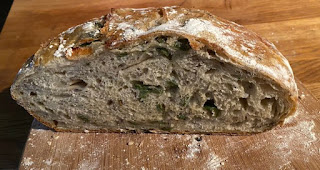Ingredients
- 1 cup (~230g) sourdough starter (if you don't have a sourdough starter, get some from a friend first or allow a couple of weeks to make one).
- 1 3/4 cups (~400g) lukewarm water
- 5 cups (~600g) all purpose or bread flour
- 1 tablespoon salt
- 1 tablespoon dried oregano
- 1 cup pitted olives, chopped approximately into quarters (I use green olives; any kind probably works, but probably avoid olives stuffed with other things.)
Instructions
- Evening before baking (allow 3-4 hours):
- Feed your sourdough starter: add equal weights of the old starter, flour (all-purpose or bread flour), and lukewarm water, and mix well. To bake the bread you will use about 1 cup of starter, so feed enough that you'll have a cup and some left over to spare for next time. For example, about 100g of starter + 100g flour + 100g water. Loosely cover the starter and leave it at room temperature until it doubles in size: probably about 2 hours depending on your starter and how warm your room is (warmer starter will rise faster).
- Once the starter has doubled in size, mix
together 1 cup (230g) of the fed starter with the water, flour, oregano, and salt. Mix until
entirely blended. If you have a stand mixer you can use the hook
attachment for a minute or two, but mixing by hand is fine also.
- Put
a tablespoon of vegetable oil (e.g. olive or avocado) into a covered
bowl or pot and tilt the bowl so the oil lines the bottom and sizes.
Relocate the dough into the oiled bowl, cover bowl and leave to sit at
room temperature for about an hour. Meanwhile prepare the olives (or other things you plan to add).
- Mix the chopped olives (and/or other additions, see suggestions below) into the bowl and fold the dough around them several times, enough so the chunks are distributed reasonably evenly throughout. Fold the edges of the dough down underneath, until you have a reasonably smooth ball on top with most the bits of olive inside dough rather than exposed, if possible.
- At this point you can either put it in the fridge overnight; or leave it another 1-2 hours at room temperature and continue with next steps.
- Day of baking:
- In the morning, dust flour over the inside of a large, covered pot (e.g. a Dutch oven) that can be safely baked. Big metal saucepan with a lid would work also, or a ceramic bowl covered by a large plate. The goal is to trap steam in the container where the bread is baking.
- Take the dough out of the fridge and place it in the bottom of the Dutch oven, allow to come to room temperature (1-2 hours)
- Preheat the oven to 400 F.
- Sprinkle
the top of the dough with flour and cut a couple of shallow lines on
top. Sprinkle some additional salt on top (optional).
- Once oven is hot, put the lid on the container and place it on a middle oven rack.
- Bake for about 45 minutes, then remove the lid and bake for 10-15 minutes longer to brown the top.
- Remove from oven and turn out onto a wire rack to cool.
- Try to allow to cool close to room temperature before cutting.
Optional variations:
Play around with other ingredients instead of or as well as olives - I've also used roasted garlic (bake a head of garlic for about 30-40 minutes then allow to cool and peel off the skin), and mozzarella cheese. Sun dried tomatoes would probably be good also. Pumpkin seeds, flax seeds, chia seeds would make a multigrain style bread. Whatever you add, you probably want to end up with about 1-1.5 cups of additions in total. You can also make just a plain sourdough by adding nothing at all - no oregano, no garlic, no olives, just the salt.



Comments
Post a Comment